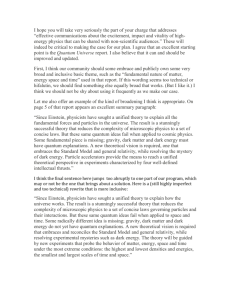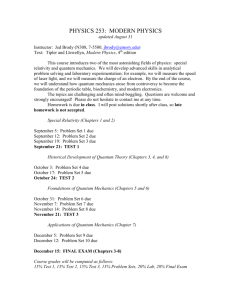1 - Ferment Magazine
advertisement
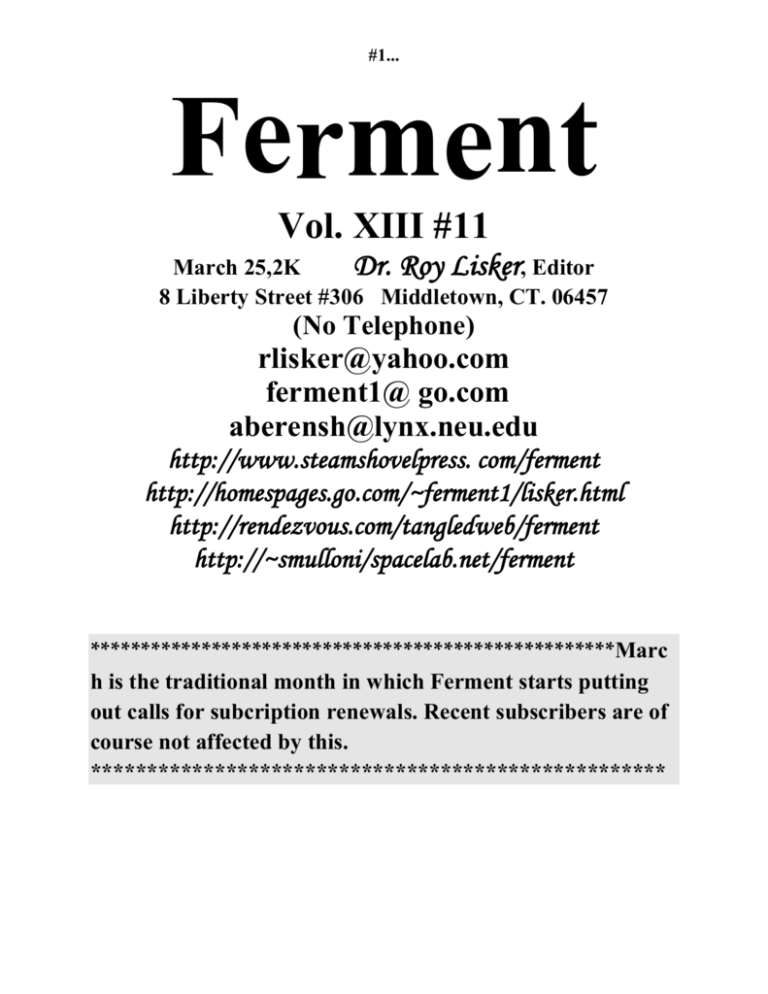
#1... Ferment Vol. XIII #11 March 25,2K Dr. Roy Lisker, Editor 8 Liberty Street #306 Middletown, CT. 06457 (No Telephone) rlisker@yahoo.com ferment1@ go.com aberensh@lynx.neu.edu http://www.steamshovelpress. com/ferment http://homespages.go.com/~ferment1/lisker.html http://rendezvous.com/tangledweb/ferment http://~smulloni/spacelab.net/ferment ****************************************************Marc h is the traditional month in which Ferment starts putting out calls for subcription renewals. Recent subscribers are of course not affected by this. *************************************************** #2... AMS Conference II : 1. Legends of a Washington Youth Hostel Tuesday, January 18th . The India House Youth Hostel is located less than a block away from the Tacoma Park subway stop, up the hill on Carroll St., on the right as one emerges from its spacious entrance. The surrounding neighborhood is desolate without being bleak, poor without really being impoverished. Adjacent to the hostel on the descending sidewalk one finds an immigrant grocery and a Jamaican restaurant. Walking up the hill in the other direction one discovers the familiar accoutrements of a neighborhood : bank, post office, 7/11 , bakery, Catholic church and associated elementary school. On the plateau at the top of the hill the tone is decidedly middle class. From the street the hostel looks like a shack. From its dominant vantage, set back from its immediate neighbors, it is as conspicuous as an historic monument. A brick wall a few feet high does service as pediment to a lawn rising obliquely up to the frame structure at its summit. Neatly bisecting this frontage is an escalade of concrete steps . A creaky railing, a construction of metal rods, is fixed to the right. In large letters the name INDIA HOUSE stands in a sign hanging above the doorway. An aura of shabbiness, neglect and decay plays around the front of the building. A glass windowpane fills the upper part of the door. I firmly grasped the doorknob and pushed: the bolt ricocheted instantly in its cradle, but did not give. Evidently the door was locked, after a fashion; it rattled on its hinges as flakes of whitewash peeled from the rotting frame. Looking into the gloomy interior I made out a desk to the right. A doorway on the left opened to an adjacent room , while just ahead I could see , through another door frame what appeared to be the dining-room and, after that, the kitchen. Then I put pressure on the bell button. #3... After a short wait a human shape materialized. Upon a short body , hoisted there by the laws of natural selection, appeared a querulous, unhappy and stupor-saturated face. It regarded me with irony, almost mockery, if not altogether with detachment, maintaining that wry contempt for the world one finds only in the very wise or deeply depressed. It seems that the owner of this face had concluded that I posed no threat. A hand thrust forward and opened the door. His name was Donald. About 5 foot 5, drabbly clothed with faded jeans and grey pullover. His mood was middle 30's, sleepy, demoralized, decidedly ‘not all there’ , easily swayed without ever being convinced, not interested in very much, yet a student of life and, in his own way, something of a humanist. Donald was surprised to learn that I'd called the hostel 3 times that morning, letting the phone ring at least 10 times on each occasion. The explanation turned out to be simple enough : he'd spent the morning hooked up to the Internet through the computer in his bedroom. My calls had been blocked by the modem. Everything about him was simple, informal, uncomplicated, and inspired no confidence whatsoever. The rent was $14 a night, payable in advance, taxes and surcharges included: One night at the Marriott for one night would have kept me at the hostel for 10. The $42 for 3 nights was gladly handed across . Donald put the money into a box on the desk with an absent air, then seemed to forget it was there. I could have retrieved it after he walked away, and he might never have noticed the difference. As we walked to the back of the small building he pointed to towels, kitchenware, dining tables. A television was going in the livingroom to the side; seated around it on a couch were 3 persons, a South American college student, an elderly bitter-faced Japanese and a short, somewhat disturbed looking girl in her 20's . As I recall they were #4... watching something related to the Super Bowl; of course I don’t know what that is. When the student learned that I was in town attending a mathematics conference, he insisted on being instructed in as much of Wiles’ proof of Fermat's Last Theorem as could be conveyed in 5 minutes. It was really difficult: the sum of my knowledge really needs about 15 minutes for its transmission. Leading the way, Donald walked with me up through a small twisting staircase at the back of the building, to the bedrooms on the second floor. We entered the first room on the right: small and barren, with ample sunlight coming in from the street. Furnishings consisted of 3 double-decker beds standing against front and back walls, and the side wall to the left. At the far right stood a small chest of drawers. Judging from the distribution of sheets and blankets, all of the lower bunks were occupied. Donald walked over to the bed on the left and yanked off the top sheet. " This guy was lots of trouble", he explained, " he's left." I'd come with my own sheets and spread them over the bed. A short nap, a bit of time to wash up, and I was headed back to the AMS Conference, 20 minutes away on the Red Line. I returned to the India House at around 10. The elderly Japanese responded to the bell and opened the door. He struck me as a man very much down on his luck, yet with cultivated notions of courtesy at variance with his environment. The light was on in the bedroom. Two students from New Zealand were lying in the top bunks, talking and reading. Someone's back-pack was on my sheets. I picked it up and carried it over to the vacant lower cot of the double-decker standing by the window. About 15 minutes passed before another occupant entered the room. He was, I would say, in his late 20's, very Southern, #5... handsome in his way with blond hair tied in a ponytail, blue jeans and denim jacket, an air of being more comfortable with the road than with either school or a home. Seeing me lying on the bed he made an imperious sweep with a forefinger, and muttered : " That's my bed!" When I didn't understand him at first , he repeated his theory. Then I explained that Donald had given me the bed at 12 noon. If he'd arrived at the hostel after that I had the priority. Abashed he went downstairs to consult with the management. It turned out that I was technically correct: Donald had given the same bed to two people. Moving his gear to the upper bunk of the bed against the window, he picked up on a conversation with the two New Zealanders that had been interrupted shortly before I arrived. It developed into a rambling harangue having to do with his firm belief that the South would not have lost the Civil War if he'd been one of the commanding generals. He discussed some major battles, one of them being Gettysburg. His concluding remarks were to the effect that the industrial might of the North had nothing to do with the ultimate outcome of the war. The real cause was bad leadership, and he could have corrected that. After hoisting the back-pack to the upper bunk he strode out of the room- and did not return for the rest of the night! Strange that he should have insisted on the right to occupy a bed he'd had no intention of using. Over the night several inches of snow fell on the city of Washington. In most Northern cities this would be considered inconsequential , but it’s evidently treated as something of a disaster in Washington - along with monogamy. Coming downstairs into the kitchen at around 7:30 AM I met Jessica, co-manager of India House. Donald was still asleep. He often was, at various times in the day, but as a general rule Jessica was around. From the beginning I found her #6... absolutely fascinating - not in the romantic way, although I suppose that may have factored into the polynomial. She was exotic, undeniably twisted, intelligent and imaginative. Her pale white , indeed clammy skin seemed interlarded with dark moving shadows , much as storm clouds move back and forth across a landscape. One could not imagine her dressed in anything other than black, ( which in fact was how she always dressed ) . She’d covered her face and forearms with a kind of skin cream that made them peculiarly unappealing, although thick lipstick somehow reversed this impression, conveying childish malice, humor, in a word devilment. Her black hair was quite badly cut, almost in open defiance to male notions of charm. Jessica was in every way the opposite to Donald. She bustled about the house, curious about everyone and eager to be helpful. When she learned that I’ve been working for a neighborhood housing organization in Middletown she mentioned the names of similar groups in the Washington area, giving me an Internet address for contacting a network of such organizations . Donald thought there wasn’t that much to see in Washington DC, particularly with snow on the ground, but Jessica directed me to the subway stop that would bring me in the neighborhood of the Smithsonian Institute. Of course Donald was right, though my question had not been answered in the spirit in which I’d asked it : what is there to see in Washington besides more propaganda? Although Jessica brought to the household a climate of vitality that was seemingly absent in Donald, I’d the impression that she was the more pathological of the two , if that’s at all possible. Donald lived as if everything might just as well be put off indefinitely, given that the ultimate catastrophe can’t be avoided. Jessica seemed overly solicitous to serve you #7... that final glass of elderberry wine. For some reason I felt a great affection for both of them. Several incidents during my stay there give one a good sense of their differing styles: 1.) On the day that it snowed I didn’t return from the conference until around 11 o’clock . The lights were on in all the rooms of the house. From the doorstep I could make out a number of persons , including Donald, standing around in the dining-room. I rang the doorbell: Donald turned around, stared at me and did nothing . I rang again. He continued to stare as if there was something upsetting in my appearance, making no move to open the door. It took a third ring before one of the other hostel residents let me in . Donald only recognized me when I came into the dining-room. By way of explanation he said : “ Oh.... it’s you. I thought you were Santa Claus.” I should explain that , owing to the snowfall I wore a white and blue woolen cap crowned by a ball-shaped pom-pom. As Donald continued to give me a blank stare , Jessica ran over and gleefully asked : “Oh! Can I feel your pom-pom?” Of course I removed the hat and passed it over to her. She cuddled and manipulated the pom-pom for a few minutes before handing it back, fully gratified. 2.) Friday, January 21, my final night at the hostel. Several residents , myself included, were seated around the large round table in the bad illumination of the dining-room. Among us sat a young man, a country music professional, playing guitar. In between he passed around his CD’s and spoke about the concert tour he was making through Tennessee and Kentucky . Successful at his profession while still in his twenties, he clearly enjoyed what he was doing. On the right sat three plump and a bit dumpy young Australian elementary school teachers. They would be flying off together to #8... England in a few days. No prospects, no jobs, they’d simply decided it was time to get out of Australia and try their prospects in the mother country. Their only contact was a friend in London who’d agreed to put them up for a bit. As one can see, we were a congenial bunch, with very different backgrounds and with no shortage of subjects for conversation. At around 10 PM Jessica flitted into the room to ask if we had everything we needed. One of the teachers observed that Jessica’s neck chain held a curious piece of metalwork. “ Oh yes: I picked it up in the west of Ireland when I was there last year!”, she explained, “ It’s what they call a shillinagog ! 1 It’s a replica of a kind of stone sculpture, something like a gargoyle that decorated the facades of the early medieval churches . Here, take a look at it.” She passed it around, “ It’s supposed to represent a naked woman using her hands to spread open the lips of her vulva!” Once she’d given this explanation it did indeed conjure up the image she’d described. “ In the early days, shillinagogs were hung on the outside walls of churches to make the population disgusted with their own bodies and discourage sex. But too many people, it seemed, were giving quite another interpretation to it, and in the late Middle Ages they were all taken down. The shillanagog must have had some kind of symbolic importance in the old Druid religion. Instead of destroying them the priests buried them underground. You’ve got shillinagogs buried in places all over Ireland , but it’s only in the last few years that somebody realized there was lots of money to be made digging them up and selling them to tourists. It’s 1The exact pronunciation escapes me. #9... become a growth industry . Now you can go into shops in Galway and buy shillinagog jewelry, shillinagog tee-shirts, shillinagog mugs, shillinagog everything! “ And with that, flapping her shillinagog like a distended vulva , Jessica cheerfully flitted out the room. 3. ) On Thursday I’d returned to the hostel at about noon to pick up things to take back to the conference. Sitting at the foot end of my bed, I opened my suitcases and set to work removing various items and putting them in my briefcase. The bed collapsed after about 10 minutes: the wooden slates at my end broke into several pieces and the mattress , with me on top of it, sank to the floor. I went downstairs and woke up Donald to let him know what had happened. The thought of so much effort appeared to weary him , but he did go upstairs with me, with some reluctance, to examine the situation. “Yes- ”, a nod of recognition , “ That sort of thing does happen now and then. You ought to change beds I suppose. We’ll get around to the repairs some day. These things take a long time around here.” I moved my gear to the lower bunk of the adjacent bedstead. Then I left for the conference. On my return to the room that night around 10 I encountered a new occupant, a burly individual. Either unaware of or indifferent to the fact that the mattress was shaped like a flattened “Z” he lay, fully clothed and asleep, in the broken bed. India House possesses a decided flavor unlike that of any other hostel in my experience. Granted, in the 80’s, the Santa Fe hostel was fairly wild because its manager was an active political anarchist. But India House has pitched its tent on the outer periphery of the Arctic Circle; one can hear the wolves howl, the ice-pack creak, and the wind coming over the glacier. #10... (2) Brian Greene and String Theory (a) Introduction The featured speaker at the AMS Conference on the morning of Wednesday, January 19th, was Brian Greene. Greene combines a unique set of talents, perhaps not so unusual in earlier centuries , but remarkable for our own time: an accomplished mathematician, accomplished physicist, and successful author of a popular book about his specialty, String Theory. These 3 activities are not so unrelated as they might at first appear. String Theory basically combines lots of mathematics with a genre of speculative fiction mixing pieces of Jules Verne, Isaac Asimov, and Lewis Carroll . In this field it is more important to be a novelist than it is to be either a mathematician or a physicist. ( Parenthetically, it was interesting to discover the extent to which the influence of physics on mathematics, a development of the last 3 decades, was reflected in the presentations at the AMS conference. Every principal speaker, all the mini-courses and the majority of its special sessions were devoted to physics-related mathematics, or to mathematics associated with computer science. There were relatively few sessions for the traditionally “pure” areas of mathematics: number theory, abstract algebra, logic, set theory or foundations. Even the sessions on subjects like Riemann surfaces, topology and graph theory clearly had tie-ins with physics and computer science . One might label this emerging new science as “physical mathematics”, as opposed to the “mathematical physics” of the last century: that is to say, pure mathematics deriving its inspiration from problems arising out of the work of physicists. ) Brian Greene’s best-selling account of String Theory for the public market is entitled The Elegant Universe , subtitled Superstrings, Hidden Dimensions, and the Quest for the Ultimate Theory. (W.W. #11... Norton, 1999 ) It’s a first-rate text , filled though it be with the usual clichés of the popular science writing genre. Anyone interested in the latest ideas on what is familiarly known as the “structure of matter”, is encouraged to read it . His lecture that morning to an auditorium packed with hundreds of mathematicians showed him equally adept in presenting the same material to persons with all the requisite backgrounds. Clearly, Greene would also have been able to make the appropriate shifts of emphasis for a room full of physicists. For example, the word “theorem” appeared on his transparencies between quotation marks ( as ““theorem” “ ) . “It’s what physicists call a theorem, “ he explained, “ I dare not call it that to an audience of mathematicians.” In both his book and his lecture, Greene’s expositions of the essentials of String Theory were lucid, compelling and concise. His expositions have greatly helped in the reinforcement of my 2 decadeslong conviction that “string theory” is high-class hokum designed to perpetuate a cottage industry for mathematical physicists, providing jobs, outlets for publication, status and tenure, and thesis subjects for graduate students for many decades to come. (b) The Cult of the String , or Ptolemy was an Amateur What strikes the unbiased reader from his first encounter with the ideas of String Theory is ( despite the title of Greene’s book, “ The Elegant Universe”) the incurability of the hideousness of its mathematics. Yet string theory physicists habitually justify its worth by naive appeals to the “aesthetic intentions of the universe.” Here is a typical quote: “....from an aesthetic standpoint, physicists find it hard to believe that nature would respect almost, but not quite all of the symmetries that are mathematically #12... possible. Of course, it is possible that an incomplete utilization of symmetry is what actually occurs, but it would be such a shame. It would be as Bach, after developing numerous intertwining voices to fill out an ingenious pattern of musical symmetry, left out the final, resolving measure.” ( The Elegant Universe, pg. 174) #13... #14... Taken out of context one cannot tell on which subject the author is most wrong-headed : nature, aesthetics or J.S. Bach. All students of Bach are aware of his unique genius ( in, for example, the Musical Offering or the Art of the Fugue) for selecting, from the 24 combinations of transpositions, inversions and retrogrades of a fugal subject, that subset, 6, or 13, or 18, which are the most effective musically. 2 As for nature: if scientists are so sure they know what nature “wants”, why bother to investigate it? A preoccupation with making nature fit the mathematics is identifiable in all string theorists. Yet the ultimate effect of their obsession with “beauty” has been a disfigurement of nature’s face so thorough-going that she has become unrecognizable. One can’t know ahead of time if the most successful model for the description of some natural phenomenon will turn out to be beautiful or ugly ( by some canon of aesthetics) . Historically the situation in the sciences has been this: when a theory becomes too over-encumbered, too top-heavy too unwieldy, the feeling becomes general that something must be seriously wrong with it, and that a new approach is needed. One of the ways of modifying or simplifying the theory is to put together a store of predictions that can be used to test it : make-or-break experiments that will either refute or partially confirm some part of the theory. The dumpsters of science overflow with scores of notions discarded by this method : Maxwell’s light-transmitting “ether”, eliminated by the Michelson-Morley experiment; “phlogiston”, abandoned following the demonstrations of Lavoisier and Priestley; the 2The notion that a composer, or indeed any artist, merely “grinds through” the symmetries of some intricate formal structure, may have its roots in the absurd essay by the mathematician G.D. Birkhoff: “Aesthetic Measure” . #15... Ptolemaic system, superseded , ( though not at first eliminated), by the Copernican system, ultimately put to rest in the 18th century by observations of the transit of Venus across the face of the sun. None of these hypotheses were abnormally far-fetched when they were first proposed: they gradually became so only through the accumulation of dozens of stratagems to save the theory at the expense of the evidence. Yet, compared to these, String Theory is a jungle gone wild, far more extravagant than any ad hoc combination of ethers, phlogistons, epicycles and flat earths could ever be. Through its dense foliage one can scarcely find a trace of falsifiability anywhere. So what is String Theory? Although it studies vacuum states, it did not come out of a vacuum; although one is sorely tempted to describe the small return on its investment of energy, intellect and labor as a ‘vacuum-vacuum expectation’! 3 The predictions of Quantum Theory and Special Relativity ( and their extensions to Quantum Field Theory and General Relativity) fit natural reality with an astounding degree of accuracy, provided they stick to their respective domains: the quantum theories for the microscopic world, the relativities for immense speeds and masses. Paradoxically, the postulates 4 of quantum theory and relativity contradict each other. For example, relativity depends on rest-frames , whereas the very notion of a “rest state” is foreign to quantum theory. 5 3Chuckle. 4Look A Quantum Field Theory joke. for example in von Neumann’s “Foundations of Quantum Mechanics”, and Roberto Torretti’s “Space-Time Geometry” 5One might say that Relativity is to Parmenides as Quantum Theory is to Heraclitus. #16... This really doesn’t matter all that much in dealing with most real-world situations, because there is a “Correspondence Principle” to carry us from the opposite extremes of these two theories back to the real world: Quantum -----------> Life In The Raw <------------ Relativity Theory Correspondence Correspondence Principle Principle The pre-occupations of contemporary physics now include 3 areas, at least, where quantum theory and relativity come together: the Big Bang, the constitution of Black Holes, and classification/unification schemes for elementary particles/forces. All of this is very well explained by Greene in Chapter 5 of “The Elegant Universe “ . The accompanying picture is to be found on page 174: #17... #18... So the problem of fitting together a pair of great theories about the universe, whose postulates are contradictory , has become important. The first string theory of the 60’s was an attempt to do this: it replaced the familiar 3-dimensional “solid” atoms of Democritus, Lucretius and Dalton, by tiny 1-dimensional vermicelli ( so tiny that no-one, even in theory , 6 would ever be able to see them) vibrating in a 10 dimensional ( 9 of space, 1 of time) cosmos. What us living creatures actually see , in our 4 -dimensions , are the resonant modes, the harmonics if you like, of these vibrations. These arise when the strings are perturbed, in the way notes come out of a violin when its strings are grazed by a horsehair bow. But who holds the bow ? The theory starts from a perturbation of something else, where that something else is not only unknown but inherently undetectable . Does Ockham shave? This theory failed, by the way. It was just waiting to be carted to the graveyard holding phlogiston, Mesmer’s magnetic fluid, humoral pathology, Cold Fusion and Lysenkoism, when, like Señor Don Gato in the children’s song , it was spontaneously reborn 7 . This resurrection was accomplished by yet another theory with no experimental and very little theoretical justification: Supergravity. When this was combined with Super-symmetry, out came Superstring Theory . Supersymmetry is a unification scheme for elementary particles associating every fermion ( matter particle with half-integer spin) , 6Theoretical undetectability is another hallmark of String Theory “When the funeral passed the market fair Such a smell of fish was in the air Although his burial was slated, Meow! Meow! Meow! He became re-animated, Meow! Meow! Meow! He came back to life, Don Gato! “ 7 #19... symmetrically with a boson ( energy particle with integral spin). VERY LOOSELY , bosons are “relativistic”, and fermions are “quantum-like ”, ( Bosonic representations are smooth and differentiable , whereas fermionic representations , ( owing to the “1/2 ” in their spin numbers ) , are discrete or discontinuous.) Supersymmetry allows one to go back and forth between these two representations, thus creating a “mirror symmetrical” picture of the universe. Unfortunately , supersymmetry requires that one double the list of known elementary particles to fill out the dualism, and over a period of 30 years not a single one of these theoretical particles has been detected by anyone : snelectrons ; sneutrinos ; squarks ; photinos ; gluinos ; winos ; zinos; etc.... The theoretical graviton , a boson of spin -2 , has a fundamental role in this theory. It, too, has never been detected, yet already has a partner: the gravitino! What would happen if the gravitino got discovered first? There simply isn’t any space here to elaborate further on string - or superstring - theories which , from the angle of the history of ideas at least, are not uninteresting. Suffice it to say that there appear to be two schools of thought current in the scientific world with respect to String Theory: School I : There must be something to it. It’s been around for 30 years and refuses to die. School II: Trente ans , ça suffit ! 30 years without a single verifiable prediction, ( even as a thought experiment), is surely enough time to demonstrate that the theory has nothing to do with physics. #20... We have polled 3 scientists for their views on this matter, and record their replies: Epistemologist : To know is to see Opthamologist : To see is to know Meteorologist : Let it snow, let it snow, let it snow ! #21... (3) Penrosism Roger Penrose , distinguished cosmologist and mathematician, has also gained public recognition through the publication of two sizable coffee table books, The Emperor’s New Mind and Shadows of the Mind . From the standpoint of public education they can be appreciated as leisurely excursions through the more interesting aspects of modern logic, physics, geometry, combinatorics and computer science. The real purpose of these treatises however appears to be the promulgation of a metaphysical system, perhaps even a religious doctrine which, for want of a better word, one can call “Penrosism” . It is in fact a grand system of nature, what in the last century was familiarly known as a Naturwissenschaft or Natural Philosophy , or even a Natural Theology It stands upon a single fundamental tenet : The mind is not a computer . I agree with this conclusion by the way , though my personal arguments are heuristic: I’ve made no attempt to dress them up with mathematical theorems . Parts of the brain certainly do function like computer components; however the mind is not co-extensive with the brain. There exist living beings, such as micro-organisms and plants, with no brain per se. Where there is life there is mind: so I believe. My own theory of psychology describing the function of the mind , as opposed to the brain, was presented in the form of a long essay Life and Life Energy , serialized in last year’s Ferment ( Ferment XII ,#8-10, Jan. 1999 ). Roger Penrose, being a world-class mathematician, is not satisfied with such vague appeals to colorful vitalist or metaphysical notions . He maintains that he’s proven his fundamental tenet by mathematical physics. Penrose’s world system has been neatly summarized by Drew #22... McDermott, ( Dept. Comp. Sci., Yale University ) . It consists of 6 points. I quote (“Penrose is Wrong”, Psyche 2(17) October 1995 ) : • Because of Gödel’s Incompleteness Theorem, mathematical insight cannot be mechanized. • Mathematical insight depends on consciousness, and so it is doubtful that any part of consciousness can be mechanized. • But then a physical system can be conscious only if it can’t be simulated by a computer. • That would be very strange; fortunately, the world in modern physics is very strange. • The interaction between quantum mechanics and the general theory of relativity is poorly understood. Fundamental questions about time and causality seem to depend on how that interaction gets worked out. 8 • Perhaps the brain exploits some large-scale quantum coherence so as to achieve consciousness. Perhaps the site of this effect is in the cytoskeletons of neurons. The whole system rests on the belief that Gödel’s Incompleteness Theorem 9 proves that the mind is not a computer. The very wording of this sentence suggests a delusional system. Indeed, it has been judged so by many accomplished thinkers in the fields of logic, computer science, neuro-psychology and so on, ever since it was announced in the late 1980’s . Penrose’s arguments are filled with technical errors, misplaced or shifting definitions, uses of subjective interpretations, and leaps of faith. It would take much too long for me to go over all of this here; instead I invite the interested reader to click onto the following website, where 8This refers to Penrose’s graviton ,which somehow interacts with the nervous system. 9No system of axioms can ever completely describe arithmetic. #23... one will find a good collection of tough-minded analyses that thoroughly demystify Penrosism: <http://psyche.cs.monash.edu.au> Between 1994 when I first heard him give a talk on this subject at a major Physics Colloquium at Boston University, and his lecture at the Washington AMS conference on the evening of Wednesday , January 19 , Roger Penrose has presented the same sermon, with minor variations, at conferences and gatherings all over the world. I knew this was going to be the case and had not intended to go to the lecture. I only went because Ely Dorsey and Lou Kauffman were and I wanted to be with them. What I consider valuable about Penrosism has little to do with its content. I do find it a cause for fascination , that the delusional systems of mathematicians share so many common features, whether their inventors be among the pioneers in their fields ( such as Penrose), or simply competent professionals, or amateurs, or blatant lunatics. Three things characterize all such systems : (1) Word play (2) Grandeur (3) Impenetrability (1) Word Play: The normal working vocabulary of mathematics is extremely bad. Apart from a traditional terminology derived from Greek and Latin , its terms are drawn from the language of everyday usage, then twisted out of shape to fit highly specific technical meanings. Examples are “group”, “ring”, “manifold”, “bundle”, “fiber”, “sheaf”, etc. Some prefixes or words , ( “regular”, “elliptic”, “complete” , semi-”, “pseudo-” ) are loaded down with too many meanings in various contexts. Finally there are words like “imaginary”, “complex”, “undecidable”, “transcendental”, “universal”, “annihilator”, and so on, #24... whose multiple overtones of connotation suggest realms of spirit and cosmos yet which, in fact, denote the most banal or even trivial technicalities. Examples: in her essay on Fermat’s Last Theorem, Marilyn vos Savant casts doubt on the validity of the recent proof by Andrew Wiles. To her way of thinking, his proof takes place in elliptic space . However, we don’t live in elliptic space, we live in Euclidean space . Therefore, she argues, his proof doesn’t apply to us. It is not only a question of ignorance. In fact she confuses elliptic functions , which Wiles investigated , with elliptic space , which has nothing to do with his result. Marilyn vos Savant is a rank amateur, strong only in certain aspects of statistics ( if in fact she even writes her own column in Parade Magazine) . It is all the more surprising that Roger Penrose, an important and brilliant thinker , does very much the same thing when, in Shadows of the Mind , he floats technical terms such as “soundness”, “strangeness” and, above all, the word “undecidability”, to extra-terrestrial realms . In the encyclopedia of mathematical delusion, the word “undecidability” is notorious for its frequency. What Roger Penrose is really saying, though not in so many words, is that because our minds can understand the concept of undecidability, they possess capabilities that computers don’t. This line of reasoning is disturbingly similar to the claim of the otherwise unremarkable ( and very deluded) mathematician Malvina Baica, that she has discovered a short proof of Fermat’s Last Theorem based on the undecidability of the determination of integral roots of an arbitrary algebraic polynomial ( David Hilbert’s “10th Problem”, proven in 1973 ) . The cardinal difference between Malvina Baica and Roger Penrose, is that while Dr. Roger was listened to in respectful silence at the AMS conference, poor Malvina was hooted #25... off the floor of the Fermat conference at Boston University in August of 1995, every time she opened her mouth. (2) Grandeur: Delusional schemes by mathematicians invariably reveal some deep, comprehensive world order that unfolds naturally from a few elementary notions that have been given a novel interpretation. The most famous example in recent scientific history is Sir Arthur Eddington’s obsessive attachment to the integer 137 . ( The “fine structure constant” of physics, a pure number, is approximately equal to 1/137 .) At the time he went into this loop, Eddington was deservedly the world’s most famous astronomer. Afterwards people just stopped listening to him, ( except when he recommended that students who didn’t agree with him be passed over for publication or promotion, as in the case of Subramanyan Chandrasekhar) . One also finds “23” fanatics; a few years ago I tutored one of them in basic Number Theory. There can be no question that the delusional system of Roger Penrose puts all previous systems in the shade. Name one other ideologue in history who brings in all of quantum theory, all of relativity, all of cosmology, quantum gravity, elementary particle theory, neuro-physiology, the foundations of arithmetic, artificial intelligence, computer science, fractals, chaos, plane tilings and supersymmetry as supporting evidence for his creed ? (3) Impenetrability: Psychologically, delusional systems are marvelously constructed defenses against an unacceptable reality. When their builders are highly intelligent they can be masterpieces of evasion, denial, self-deception, rationales, shifting ground and, when pushed against the wall, personal attacks on all critics. #26... None of this is news: what is particularly remarkable is the possibilities for building these systems inside mathematics , the only discipline in all of science in which a theory can be completely refuted, without hope of reprieve, by a single contradiction. It takes the mind of a Penrose to find a way around this. His talk at the AMS conference, in addition to being a rehash of his basic thesis, also contained a number of new arguments against traditional criticisms, including at least one interesting idea ( a tiny ‘uncertainty’ in the energy operator of quantum theory which would have consequences on the measurement of time ) , combined with a scheme for measuring this uncertainty unworthy of a junior high school science lab. A cautionary note : Let us never forget that there are no atheists in foxholes. We are all Penroses under the skin. TS Eliot never coined a truer phrase than when he wrote :’ ...human kind /Cannot bear very much reality’ . Still it should be seen as a misfortune when certain individuals, because of their fame and influence , are designated to carry and reveal their private delusional system to the four corners of the globe. References: (1) Hostels U.S.A. : At-a-Glance Ratings; Candid Descriptions; Local Cheap Eats; Guest Comments; Evan Halper and Paul Kan; The Globe Press, 1999 ; Page 100 (2) The Elegant Universe; Brian Greene: W W Norton & Co., 1999 (3) The Emperor’s New Mind; Roger Penrose; Oxford UP, 1989 (4) Shadows of the Mind; Roger Penrose; Oxford UP, 1994 #27... #28...
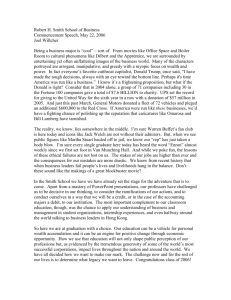
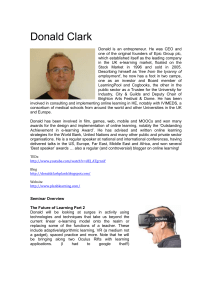

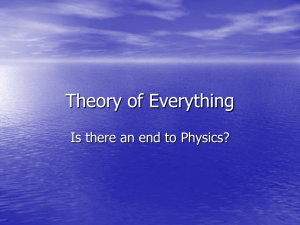


![[#SWF-809] Add support for on bind and on validate](http://s3.studylib.net/store/data/007337359_1-f9f0d6750e6a494ec2c19e8544db36bc-300x300.png)
